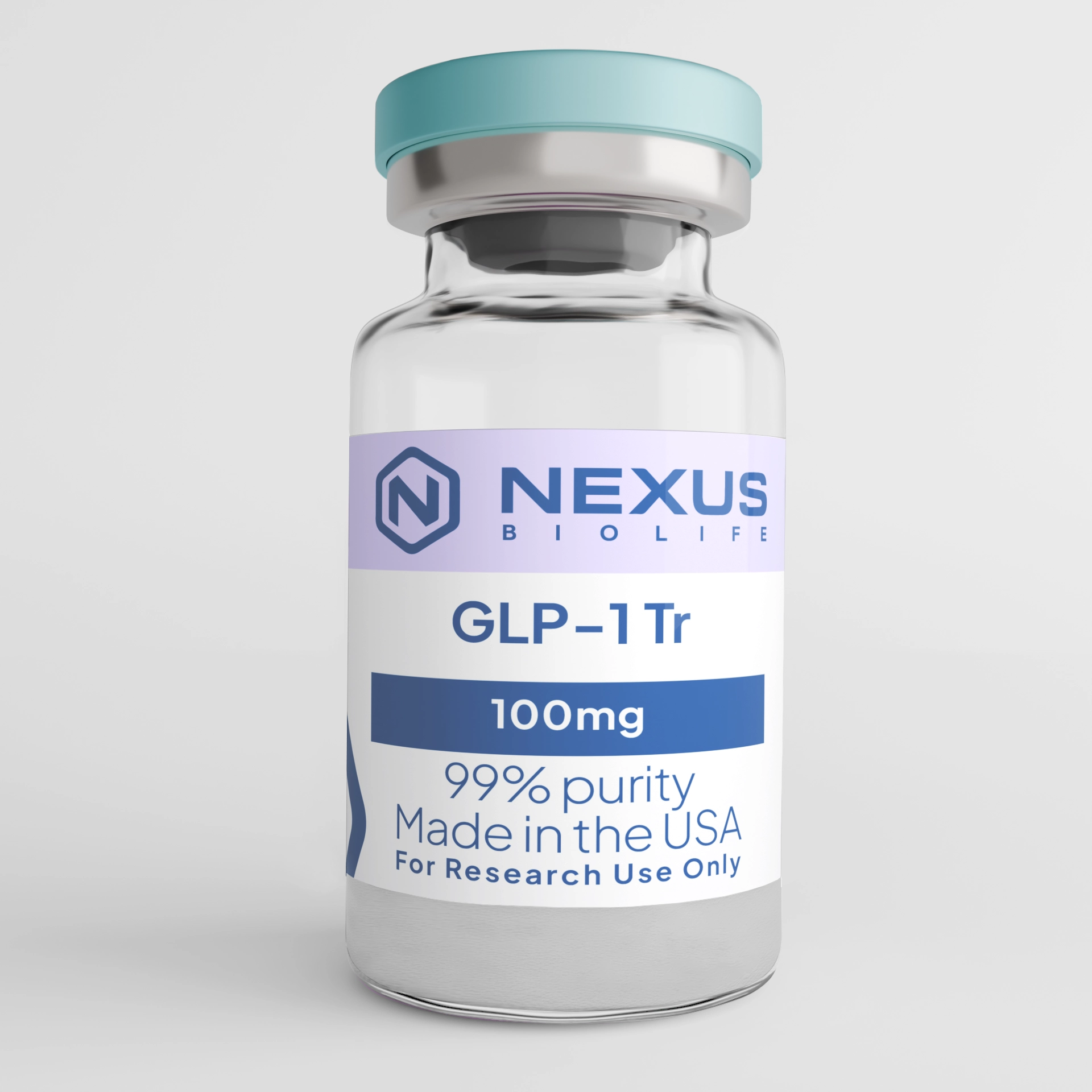

GLP-1 Tr's structure is a linear 39-amino-acid chain: Y-Aib-E-G-T-F-T-S-D-Y-S-I-Aib-L-D-K-I-A-Q-K(acyl)-A-F-V-Q-W-L-I-A-G-G-P-S-S-G-A-P-P-P-S-NH2, where Aib denotes 2-aminoisobutyric acid at positions 2 and 13, and the lysine at position 20 is acylated with a C20 fatty diacid via a linker composed of γ-glutamic acid and two 8-amino-3,6-dioxaoctanoic acid (AEEA) units. This sequence draws from the native GIP backbone, incorporating elements from GLP-1 and exendin-4 for optimized receptor binding, with a molecular formula of C225H348N48O68 and a molecular weight of approximately 4813 Da. The fatty acid modification promotes high-affinity binding to albumin (>99%), extending its half-life to about 5 days and supporting sustained activity in experimental setups.
These enhancements confer greater resistance to proteolytic degradation compared to native incretins, while maintaining an alpha-helical conformation crucial for receptor engagement. In lab applications, GLP-1 Tr is supplied as a lyophilized powder with purity typically over 98%, as verified by HPLC and mass spectrometry. It exhibits solubility in neutral aqueous buffers, though the lipid moiety may necessitate careful reconstitution to avoid micelle formation. Our quality assurance processes ensure transparency, with each batch tested for consistency so you can proceed with your studies reliably.
GLP-1 Tr is a synthetic 39-amino-acid peptide engineered as a dual agonist for the glucose-dependent insulinotropic polypeptide (GIP) and glucagon-like peptide-1 (GLP-1) receptors, designed to mimic and enhance the actions of these incretin hormones in metabolic research models. With modifications including non-natural amino acids and a fatty acid conjugation for extended stability, it serves as a potent tool for in-vitro investigations into glucose homeostasis, insulin secretion, and energy regulation. As with all our peptides, GLP-1 Tr is provided exclusively for research purposes and in-vitro use only—not for human consumption or any clinical applications.
GLP-1 Tr operates as a balanced dual agonist, activating both GIP and GLP-1 receptors with affinities comparable to or slightly adjusted from native ligands—equal to GIP at GIPR and about fivefold weaker than GLP-1 at GLP-1R. This co-agonism stimulates glucose-dependent insulin secretion from pancreatic beta cells via cAMP pathways, suppresses glucagon release from alpha cells, and enhances insulin sensitivity in peripheral tissues. Additionally, it slows gastric emptying (with tachyphylaxis over time) and reduces appetite through central nervous system signaling, potentially involving hypothalamic regulation of food intake.
At the GLP-1R, GLP-1 Tr displays biased signaling favoring cAMP production over β-arrestin recruitment, which may minimize receptor desensitization and contribute to prolonged efficacy in models. The GIP component adds complementary effects, such as promoting lipogenesis inhibition and energy expenditure, creating synergy that amplifies metabolic outcomes beyond single-receptor agonists. In in-vitro assays, this leads to dose-dependent increases in insulin release and reductions in inflammatory markers, offering a clear picture of incretin crosstalk. We're excited to help demystify these processes—GLP-1 Tr provides a logical framework for understanding how dual receptor activation fine-tunes endocrine responses.
In wrapping up, GLP-1 Tr stands as a groundbreaking dual GIP/GLP-1 agonist, empowering researchers to dissect multifaceted metabolic pathways with its unique structure and synergistic actions on insulin dynamics and energy balance. Its versatility in modeling complex endocrine interactions fuels our shared passion for advancing peptide science through quality tools and clear education. Strictly for in-vitro research, GLP-1 Tr exemplifies our dedication to integrity and approachability in supporting your work. Let's collaborate to reveal new horizons in metabolic research, one precise study at a time.
GLP-1 Tr's dual-receptor profile makes it highly suitable for in-vitro and ex-vivo research in type 2 diabetes, obesity, and related metabolic syndromes. In cell-based models expressing GIP and GLP-1 receptors, such as pancreatic islets or adipocytes, it has been used to quantify cAMP accumulation, insulin secretion kinetics, and glucagon suppression under varying glucose conditions. Studies in hepatocyte cultures explore its effects on gluconeogenesis and lipid metabolism, revealing reductions in triglyceride accumulation and improvements in insulin signaling pathways.
Beyond glucose control, GLP-1 Tr supports investigations into weight regulation, with assays demonstrating enhanced energy expenditure and appetite modulation in hypothalamic neuron models. Its potential in non-alcoholic fatty liver disease (NAFLD) research is notable, where it has been applied to probe reductions in hepatic steatosis and inflammation in tissue slices. Emerging applications include neuroprotective studies, such as in Alzheimer's models, assessing its impact on cognitive markers via incretin signaling. We recommend it for comparative assays with single agonists to highlight synergistic effects, and our team can share insights on protocol design to maximize your findings while ensuring safe handling.
To optimize GLP-1 Tr for your experiments, store the lyophilized powder at -20°C or below in a desiccated, light-protected container to safeguard the fatty acid linkage and prevent degradation. Reconstitute with sterile bacteriostatic water or a neutral buffer to concentrations of 1-5 mg/mL, using gentle agitation to fully dissolve without foaming, as excessive mixing could compromise the structure. Given its albumin-binding affinity, consider adding carrier proteins like BSA to solutions if low concentrations are needed for assays.
Reconstituted aliquots can be stored at 2-8°C for up to a week or frozen for longer periods, but avoid multiple freeze-thaw cycles to maintain activity. Our testing confirms stability under these guidelines, but always check for clarity and pH neutrality before use. If you run into any challenges, we're here with practical, step-by-step advice drawn from evidence-based practices.
GLP-1 Tr is a synthetic 39-amino-acid peptide engineered as a dual agonist for the glucose-dependent insulinotropic polypeptide (GIP) and glucagon-like peptide-1 (GLP-1) receptors, designed to mimic and enhance the actions of these incretin hormones in metabolic research models. With modifications including non-natural amino acids and a fatty acid conjugation for extended stability, it serves as a potent tool for in-vitro investigations into glucose homeostasis, insulin secretion, and energy regulation. As with all our peptides, GLP-1 Tr is provided exclusively for research purposes and in-vitro use only—not for human consumption or any clinical applications.
GLP-1 Tr operates as a balanced dual agonist, activating both GIP and GLP-1 receptors with affinities comparable to or slightly adjusted from native ligands—equal to GIP at GIPR and about fivefold weaker than GLP-1 at GLP-1R. This co-agonism stimulates glucose-dependent insulin secretion from pancreatic beta cells via cAMP pathways, suppresses glucagon release from alpha cells, and enhances insulin sensitivity in peripheral tissues. Additionally, it slows gastric emptying (with tachyphylaxis over time) and reduces appetite through central nervous system signaling, potentially involving hypothalamic regulation of food intake.
At the GLP-1R, GLP-1 Tr displays biased signaling favoring cAMP production over β-arrestin recruitment, which may minimize receptor desensitization and contribute to prolonged efficacy in models. The GIP component adds complementary effects, such as promoting lipogenesis inhibition and energy expenditure, creating synergy that amplifies metabolic outcomes beyond single-receptor agonists. In in-vitro assays, this leads to dose-dependent increases in insulin release and reductions in inflammatory markers, offering a clear picture of incretin crosstalk. We're excited to help demystify these processes—GLP-1 Tr provides a logical framework for understanding how dual receptor activation fine-tunes endocrine responses.
In wrapping up, GLP-1 Tr stands as a groundbreaking dual GIP/GLP-1 agonist, empowering researchers to dissect multifaceted metabolic pathways with its unique structure and synergistic actions on insulin dynamics and energy balance. Its versatility in modeling complex endocrine interactions fuels our shared passion for advancing peptide science through quality tools and clear education. Strictly for in-vitro research, GLP-1 Tr exemplifies our dedication to integrity and approachability in supporting your work. Let's collaborate to reveal new horizons in metabolic research, one precise study at a time.
GLP-1 Tr's structure is a linear 39-amino-acid chain: Y-Aib-E-G-T-F-T-S-D-Y-S-I-Aib-L-D-K-I-A-Q-K(acyl)-A-F-V-Q-W-L-I-A-G-G-P-S-S-G-A-P-P-P-S-NH2, where Aib denotes 2-aminoisobutyric acid at positions 2 and 13, and the lysine at position 20 is acylated with a C20 fatty diacid via a linker composed of γ-glutamic acid and two 8-amino-3,6-dioxaoctanoic acid (AEEA) units. This sequence draws from the native GIP backbone, incorporating elements from GLP-1 and exendin-4 for optimized receptor binding, with a molecular formula of C225H348N48O68 and a molecular weight of approximately 4813 Da. The fatty acid modification promotes high-affinity binding to albumin (>99%), extending its half-life to about 5 days and supporting sustained activity in experimental setups.
These enhancements confer greater resistance to proteolytic degradation compared to native incretins, while maintaining an alpha-helical conformation crucial for receptor engagement. In lab applications, GLP-1 Tr is supplied as a lyophilized powder with purity typically over 98%, as verified by HPLC and mass spectrometry. It exhibits solubility in neutral aqueous buffers, though the lipid moiety may necessitate careful reconstitution to avoid micelle formation. Our quality assurance processes ensure transparency, with each batch tested for consistency so you can proceed with your studies reliably.

GLP-1 Tr's dual-receptor profile makes it highly suitable for in-vitro and ex-vivo research in type 2 diabetes, obesity, and related metabolic syndromes. In cell-based models expressing GIP and GLP-1 receptors, such as pancreatic islets or adipocytes, it has been used to quantify cAMP accumulation, insulin secretion kinetics, and glucagon suppression under varying glucose conditions. Studies in hepatocyte cultures explore its effects on gluconeogenesis and lipid metabolism, revealing reductions in triglyceride accumulation and improvements in insulin signaling pathways.
Beyond glucose control, GLP-1 Tr supports investigations into weight regulation, with assays demonstrating enhanced energy expenditure and appetite modulation in hypothalamic neuron models. Its potential in non-alcoholic fatty liver disease (NAFLD) research is notable, where it has been applied to probe reductions in hepatic steatosis and inflammation in tissue slices. Emerging applications include neuroprotective studies, such as in Alzheimer's models, assessing its impact on cognitive markers via incretin signaling. We recommend it for comparative assays with single agonists to highlight synergistic effects, and our team can share insights on protocol design to maximize your findings while ensuring safe handling.
To optimize GLP-1 Tr for your experiments, store the lyophilized powder at -20°C or below in a desiccated, light-protected container to safeguard the fatty acid linkage and prevent degradation. Reconstitute with sterile bacteriostatic water or a neutral buffer to concentrations of 1-5 mg/mL, using gentle agitation to fully dissolve without foaming, as excessive mixing could compromise the structure. Given its albumin-binding affinity, consider adding carrier proteins like BSA to solutions if low concentrations are needed for assays.
Reconstituted aliquots can be stored at 2-8°C for up to a week or frozen for longer periods, but avoid multiple freeze-thaw cycles to maintain activity. Our testing confirms stability under these guidelines, but always check for clarity and pH neutrality before use. If you run into any challenges, we're here with practical, step-by-step advice drawn from evidence-based practices.
